Soviet SAU of times of war (part 1) - Su-76
An attempt to develop a fully armored self-propelled gun armed with an 76-mm cannon, the Gorky Automobile Plant, on its own initiative, launched the 1941 of the year in the fall. At the same time the company mastered the production of a light tank T-60 and were engaged in designing a more advanced machine - T-70. Using the elements of the transmission and the undercarriage of these tanks, the designers created an SU-71 self-propelled artillery gun with two parallelly arranged automobile 6-cylinder engines GAZ-202. Along with it, there were works on a unified SU-72 anti-aircraft installation with a 37-mm automatic cannon in a rotating turret. However, in the end, none of the machines in the series did not go.
The situation changed only in the spring of 1942, when a turn came in the USSR in increasing the production of armored vehicles and the task of creating an ACS rose with a new force. It was quite obvious that in the present conditions of war, infantry, cavalry and tanks should be supported by self-propelled artillery, which could easily maneuver on the ground, move closer to the enemy and be protected from its machine-gun fire. SAUs could effectively and without long preparation destroy enemy tanks and their firing points with direct fire, as well as from closed positions.
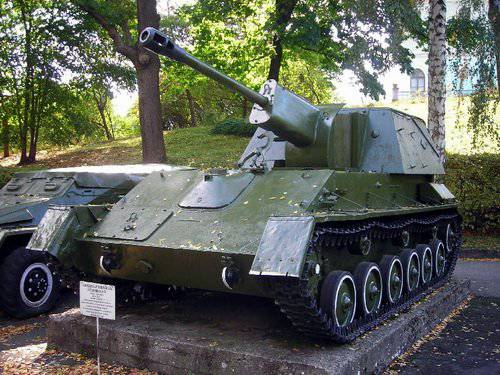
By July 1942, the first model of the self-propelled gun OCU-76 was built, created on the basis of the T-60 tank, but equipped with a cheaper M-1 automobile engine in production. This vehicle turned out to be unstable when firing because of its rather short base, and its armor protection was too weak. In fact, to create a fully-fledged, mobile, sufficiently protected self-propelled divisional gun of limited mass (up to 10 tons), which the light tank chassis would withstand, was a nontrivial task.
Realizing the need for self-propelled guns for the front, the State Defense Committee (GKO) by 1 December 1942, commissions to create a new self-propelled unit. This time they took as a basis the chassis of the T-70 tank, which was well mastered by industry. The combat compartment of the SAU was located in the rear so that the barrel of the ZIS-3 gun did not extend beyond the dimensions of the vehicle. The power plant included 2 in parallel operating the engine GAZ-202 with a total capacity of 140 HP. Exactly the same engine (in one copy) was used on the T-60 tank.
First of all, designers were attracted by the possibility of moving the ACS on one engine when another fails, as well as the unification of the machine with used units and the ease of replacement. The design for some reason did not take into account the experience of the unsuccessful use of blocks of two parallel motors that would work on the 1 output shaft. The creators ignored the serial connection of the engines in line, which was already used on the T-70 tank. Be that as it may, the self-propelled gun was tested and put into service under the designation SU-76. Its mass production began in January 1943, and at the end of the month the first regiment 2 armed with ACS data left for the Volkhov front. Here the car and "showered." A congenital defect of such an engine connection has been felt - when operating, resonant torsional vibrations arose, which very soon led to the failure of the transmission.
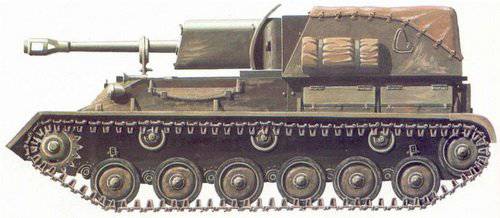
In March, 1943, the production of ACS was stopped (about 170 machines were released). The car had to get rid of all the shortcomings in the shortest possible time. As a result, by May 1943, a new version, called SU-76M, was put on the conveyor. The car was quickly reworked for installing the engine from the T-70 tank, the roof was removed from the crew compartment, which interfered with the guidance of the gun and the calculation, simplified transmission and control, and the weight of the car decreased from 11,2 to 10,5 tons. Already in July, 1943, the new self-propelled gun received a baptism of fire during the battle of Kursk.
Description of construction
SU-76 is a half-open SAU with rear combat compartment. In front of the armored hull housed the driver's seat, the propulsion system and transmission, gas tanks. The engine was located to the right of the centerline of the self-propelled gun. The gun, ammunition and the places of the rest of the crew members were located in the rear part of the military cabin, which was open above and behind.
The fighting compartment was a cabin, which was defended by two side and front armor plates. Reservations were differentiated bulletproof. Frontal sheet of the cabin body thickness of 35 mm. was located at an angle of 60 degrees to the normal, the side walls of the cabin had a thickness of 10 mm. and located at an angle of 25 degrees. Booking self-propelled guns protected the crew of 4 people from small fire weapons and large fragments. The rear wall of the cabin was lower than the sides and had a special door. For protection from the weather on the self-propelled, a canvas awning was used, which served as a roof. The SAU commander was located to the right of the gun, the gunner to the left, and the loader from behind. All SU-76 machines were equipped with receiving and transmitting radio stations and a tank intercom.
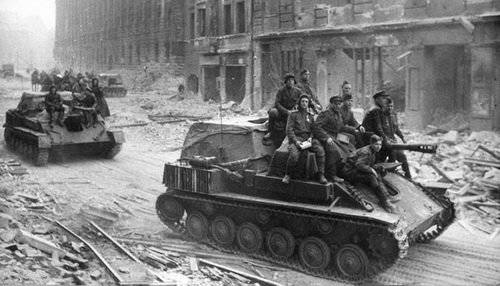
SAU SU-76 was equipped with a power plant, which consisted of two 4-stroke inline six-cylinder carburetor engines GAZ-202 with a total power of 140 hp. ACS of the later series of release were equipped with the forced to 85 HP. engines. Self-propelled suspension was torsional, individual for each of the 6 small-diameter support rollers (on each side). The drive wheels were in front, while the sloths were identical to the road wheels.
On the highway, the self-propelled gun could accelerate to 41-45 km / h, the speed on the ground was lower and was 25 km / h. Cruising on the highway was equal to 250 km., Over rough terrain - 190 km. Su-76 could overcome a trench up to 2 meters wide, climb a mountain with a slope of 30 degrees and overcome a ford to a depth of 0,9 meters. Due to the low ground pressure (total 0,545 kgf / cm.kv.), The Su-76 could move quite easily in a wooded and marshy area, supporting the infantry where the medium tanks and other SPGs could not help. The developed cooling system and the availability of a fail-safe engine preheater made it possible to operate the machine at any time of the year throughout the Soviet-German front from the northern regions of Karelia to the Crimea. Automotive 6-cylinder engines, which were mastered in production shortly before the outbreak of the war, successfully worked in a tight tank mode. Unusual installation of engines in the "back of the head" to each other anywhere in the world is no longer used.
The main weapon of the self-propelled gun was the ZIS-3 universal divisional weapon. A sub-caliber projectile of this gun at a distance of half a kilometer was able to penetrate armor up to 91 mm thick. That is, the gun could hit any part of the hull of German medium tanks, as well as the board of the "Tigers" and "Panthers". Additionally, the self-propelled guns had a portable DT machine gun for self-defense, for the same purpose the crew could use PPS and PPSh submachine guns, as well as several F-1 hand grenades.
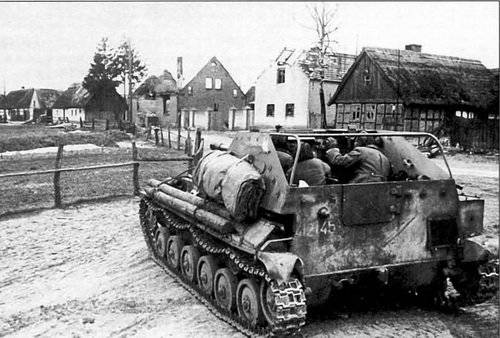
The ZIS-3 gun had a barrel length of 40 calibers, a wedge vertical shutter and a semiautomatic mechanism. The armor-piercing projectile of this gun weighed 6,3 kg, high-explosive fragmentation - 6,2 kg. The initial velocity of the armor-piercing projectile was equal to 662 m / s. The gun was mounted on the machine for the armor shield felling. The recoil mechanisms were enclosed in an armored casing. Sighting equipment consisted of a regular panoramic sight. The corners of the vertical pickup ranged from -5 to + 15 degrees, the angles of the horizontal pickup were equal to 15 degrees (in each direction). Ammunition self-propelled guns included 60 unitary shots, among which could be armor-piercing, high-explosive and cumulative. Sufficiently trained calculation could achieve rate of fire at the level of 8-10 shots per minute.
The small metal consumption of the ACS SU-76, as well as the use in its design of well-developed automobile components and assemblies by the Soviet industry, determined its mass production. Which in turn made it possible in the shortest possible time to strengthen and compact the artillery orders of infantry, which quickly fell in love and appreciated these machines. A total of 1943 to 1945 year was produced 14 292 similar SAU. It was SU-76 that became the second in terms of output after the T-34 tank an armored vehicle of the Red Army.
Combat application
SU-76 was intended for infantry support on the battlefield and was used as a light assault gun or PT-ACS. It completely replaced the light tanks of the immediate support of the infantry, which were common in the Red Army. In this case, the evaluation of the car was quite controversial. The SAU SU-76 infantrymen liked it, since its firepower was superior to the T-70 tank, and the open wheelhouse made it possible to work closely with the crew, especially in urban battles. At the same time, the self-propelled guns themselves often noted the weak points of the machine, which included, in particular, weak bullet-proof reservations, an increased fire hazard from the gasoline engine and an open wheelhouse, which did not protect against fire from above. At the same time, the open wheelhouse was convenient for the crew’s work, and also removed the problem of gas pollution in the crew compartment during firing, and also allowed, if necessary, to quickly leave the ACS. Also the positive sides of the car were - reliability, ease of maintenance, low noise, high traffic.
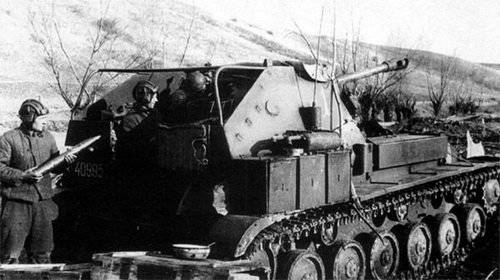
As a PT-SAU, the SU-76 could quite successfully deal with all types of light and medium Wehrmacht tanks, as well as with equivalent German SAUs. Self-propelled gun had a chance to win even against the "Panther", punching its thin side armor. At the same time against the "Tiger" and heavier vehicles, it was ineffective. When meeting with heavy tanks, the crew could fire on the undercarriage or try to damage the barrel, as well as hit the side from close range. The introduction of sub-caliber and cumulative shells into ammunition somewhat simplified the fight against well-armored targets, but did not completely solve the problem.
Proper use of terrain and camouflage while maneuvering from one shelter dug in to the ground to another allowed experienced SAU crews to successfully repel German tank attacks. Sometimes SU-76 was used to fire from closed positions. The elevation angle of its gun was the highest among all Soviet self-propelled guns, and the maximum firing range was 17 km. At the final stage of the war, self-propelled guns were often used as ersatz-armored personnel carriers, vehicles for evacuating the wounded, and also as a machine of advanced artillery observers.
Performance characteristics: SU-76
Mass: 10,5 t.
Dimensions:
Length 5 m., Width 2,74 m., Height 2,2 m.
Crew: 4 people.
Reservations: from 7 to 35 mm.
Armament: 76,2-mm gun ZIS-3
Ammunition: 60 shells
Engine: two 6-cylinder petrol engines GAZ 202, hp power 70 each.
Maximum speed: on the highway - 44 km / h, over rough terrain - 25 km / hour
Power reserve: on the highway - 250 km., Over rough terrain - 190 km.
Information